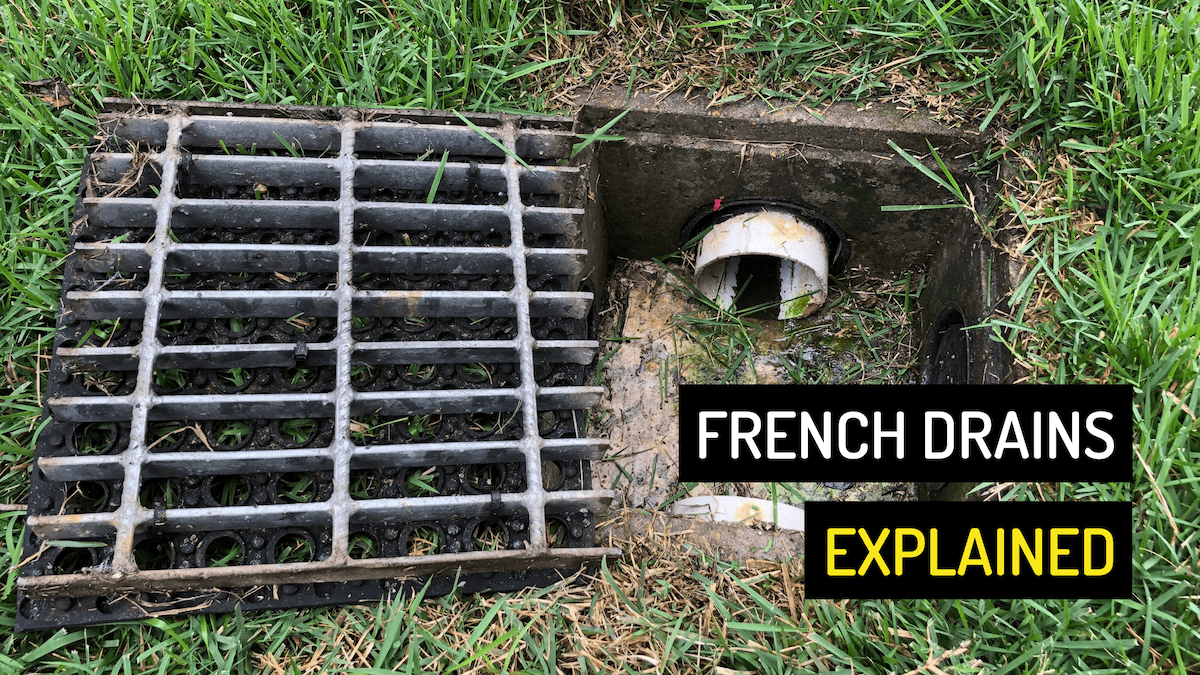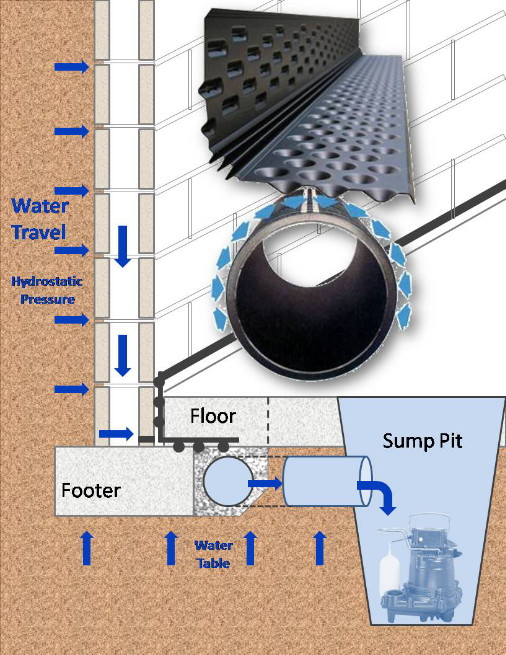The Necessary Overview to Preserving Your French Drain for Resilient Efficiency
Maintaining your French drainpipe is crucial to its effectiveness and your residential property's protection. Regular checks can save you from pricey repair services and water damages. You'll would like to know what indications to try to find and exactly how often to inspect your system. Plus, recognizing the cleansing procedure can make a substantial difference. Allow's explore the necessary actions for guaranteeing your drainpipe operates well for years ahead.
Comprehending the Function of a French Drainpipe
A French drain is a vital part in handling water around your home. It directs excess water away from your foundation, avoiding flooding and damage. When hefty rain drops, the drainpipe accumulates water through a perforated pipeline hidden in crushed rock. This system permits water to stream openly, lowering pressure on your cellar wall surfaces and decreasing the danger of leaks.You could question just how it works in practice. As water fills the soil, gravity pulls it toward the drainpipe. The perforated pipeline catches this water, delivering it to a designated water drainage location or storm sewage system. This procedure keeps your lawn dry and safeguards your home's structural integrity.Understanding exactly how a French drain features is essential to valuing its relevance. By properly funneling water away, it aids keep a risk-free and completely dry living environment. So, maintaining your French drain in top condition warranties you prevent costly repair work down the line.
Routine Examinations: What to Search for
Begin by inspecting for any type of obstructions that may be blocking water flow when you're examining your French drainpipe. Pay attention to indications of surface area disintegration around the drain, as this can indicate possible issues. Regular evaluations will help maintain your drainage system working effectively.
Blocked Drain Assessment
How can you tell if your French drainpipe is blocked? Initially, watch for water pooling in your lawn, specifically after heavy rain. That's a red flag if you discover locations where water accumulates rather of draining pipes. You must additionally inspect the drain electrical outlet; if water isn't draining as it should, there's most likely an obstruction. Listen for unusual gurgling noises, which can indicate trapped air. Furthermore, examine the drainpipe's surface for any kind of plant life growth, as roots can penetrate and obstruct the system. Ultimately, if you scent moldy odors, it can indicate stationary water triggered by a blockage. On a regular basis assessing these indications can aid you maintain your French drain successfully and avoid expensive repair services.
Surface Erosion Examine

Cleaning Your French Drainpipe: Step-by-Step Overview
Cleaning your French drain is important for maintaining it functioning properly. You'll require some specific tools and a clear procedure to ensure whatever runs efficiently. Allow's stroll with the steps and tips for maintaining your drain successfully.
Devices You'll Require
To take on the job of cleansing your French drain efficiently, you'll wish to gather a couple of important devices. Initially, get a strong pair of gloves to secure your hands from particles and sharp items. A small shovel or trowel will aid you eliminate dust or obstructions around the drainpipe. For removing out the interior, a plumbing's snake or a high-pressure water nozzle can be exceptionally valuable. You'll additionally need a container for accumulating any kind of particles you take out. Ultimately, having a yard hose pipe accessible will make it easier to wash out the drain and guarantee it's flowing smoothly. With these devices all set, you'll be set for a comprehensive cleaning session!
Cleaning Refine Actions
Beginning by examining the area around your French drainpipe for any type of visible debris or blockages. Eliminate fallen leaves, branches, or dust that may block water flow. Next off, inspect the inlet and electrical outlet areas; clear any obstructions to guarantee proper drainage. Make use of a garden tube to purge the drain, routing water into the inlet. This assists dislodge any kind of accumulated sludge or debris. If you discover consistent blockages, consider using a plumbing's serpent to damage them up. After cleaning, evaluate the crushed rock around the drainpipe; restore it if it's gotten rid of. Finally, verify the drainpipe covers are undamaged and firmly in position to avoid particles from entering. Regular cleaning keeps your French drainpipe working effectively.
Maintenance Frequency Tips
While regular upkeep is vital for your French drain's durability, recognizing just how commonly to maintain it can make all the difference. Ideally, you ought their explanation to inspect your French drain a minimum of twice a year, ideally in spring and autumn. After hefty rainfall or snowmelt, look for obstructions or debris. If you see any type of standing water, it's time to clean your drain.In locations with hefty foliage, even more regular maintenance-- regarding every 3 months-- may be necessary. Furthermore, consider cleaning your French drainpipe after significant storms or if you observe water merging in your yard. By staying aggressive, you'll guarantee your French drain features properly and safeguards your residential property from water damage. Routine checks will certainly save you time and money in the lengthy run.
Recognizing Typical Problems and Their Solutions
When you see water merging in your yard or damp areas in your basement, it's vital to recognize typical problems with your French drain and apply reliable services. One regular trouble is clogging, typically brought on by debris like leaves or debris. To repair this, you can use a pipes serpent or a high-pressure water jet to clear blockages.Another problem may be inappropriate incline. If your drain isn't sloped appropriately, water will not flow away from your home. You can adjust the incline by digging and rearranging the drainpipe pipe.Lastly, check for damage or cracks in the drain itself. Changing the harmed areas is vital for peak performance if you find any kind of. By addressing these concerns quickly, you'll assist assure that your French drain remains to operate effectively, shielding your property from water damages and maintaining a completely dry, risk-free environment.
Seasonal Upkeep Tips for Your French Drain
Attending to common issues with your French drain is just the first step in ensuring its lasting efficiency. Seasonal upkeep is important for peak efficiency. In the springtime, eliminate leaves and debris that might have built up throughout winter months. Inspect for any obstructions in the electrical outlet or catch container, as water requires a clear path to stream freely.During summer season, check your drain for any indications of shifting or resolving soil. Ensure it's still level and functioning appropriately. As autumn approaches, tidy out any kind of fallen leaves to stop blockages before winter months arrives.In winter months, look for freezing temperatures. Make certain your drain isn't at danger of cold if you live in a chilly climate. Shielding subjected pipelines can help. Normal checks and timely maintenance can protect against costly fixings and keep your French drainpipe working efficiently year-round. Keep aggressive and appreciate peace of mind knowing your water drainage system remains in good condition!
When to Call in a Specialist
Recognizing when to contact a specialist can save you time and protect against further damage to your French drain. If you observe consistent standing water in your lawn, it's a clear indicator that your drainpipe may be obstructed or harmed. Do not overlook weird odors, as they can indicate sewer back-up or degeneration, which calls for prompt attention.If you find that your drainpipe isn't operating effectively after attempts to tidy or maintain it, it's time to you could try here connect for specialist help. Furthermore, if you're not sure concerning the underlying issues or do not have the essential devices, hiring an expert can offer tranquility of mind.Finally, if your French drain is old or has experienced significant deterioration, expert evaluation can determine whether repairs or total replacement is required. Count on the specialists to guarantee your drainage system functions successfully for years ahead.
Tips for Avoiding Future Water Drainage Problems
To maintain your French drain functioning successfully, frequently inspecting and preserving it can make all the difference. Begin by clearing particles, leaves, and dirt from the surface and drainpipe openings. click to find out more This stops blockages that can result in water back-up. Inspect the gravel around the drainpipe; if it's compressed or eroded, think about including fresh crushed rock to maintain ideal flow.Next, draw away water away from your drain by making sure downspouts and gutters are clear and directing water at the very least 3 feet away from your structure. Frequently check for any type of signs of damages or drooping. If you see problems, resolve them immediately.Finally, consider installing a catch or a filter basin to trap bigger particles before it enters the drain. By staying positive with these ideas, you'll decrease the threat of future drain problems and keep your French drainpipe in top form.
Regularly Asked Questions
How Long Does a French Drain Usually Last?
A French drain generally lasts around 30 to 40 years, depending on the products utilized and upkeep (Portland French Drain). If you stay on par with regular checks, you can prolong its life expectancy even better
Can I Set Up a French Drain Myself?
Yes, you can set up a French drain yourself if you've obtained the right tools and expertise. Just make certain to prepare very carefully, adhere to local laws, and warranty proper drainage to stay clear of future problems.
What Products Are Used in a French Drain?
You'll need perforated pipeline, crushed rock, landscape fabric, and a solid drain pipe for your French drainpipe. These products aid reroute water successfully, avoiding flooding and maintaining your residential property safe and dry from water damage.

Is a License Required to Set Up a French Drain?
You'll likely need a license to mount a French drainpipe, depending upon neighborhood policies. Inspect with your district to guarantee you abide by any type of necessary guidelines and prevent potential problems during setup.
What Are the Expenses Connected With French Drain Maintenance?
Preserving a French drain usually sets you back between $100 and $500 every year. You'll require to think about expenditures for cleansing, repair work, and assessments. Normal maintenance aids protect against larger expenses and warranties your system works properly for years - Portland French Drain. When you're examining your French drain, beginning by checking for any kind of obstructions that might be blocking water flow. By remaining positive, you'll guarantee your French drainpipe features properly and safeguards your home from water damages. When you discover water pooling in your backyard or damp spots in your basement, it's vital to identify typical concerns with your French drainpipe and execute effective remedies. You can change the slope by digging and rearranging the drain pipe.Lastly, check for damages or splits in the drain itself. Examine the gravel around the drainpipe; if it's compacted or deteriorated, consider adding fresh gravel to maintain perfect flow.Next, draw away water away from your drain by making certain rain gutters and downspouts are clear and directing water at least three feet away from your foundation
Comments on “Top Advantages of Setting Up a Portland French Drain Near Your House”